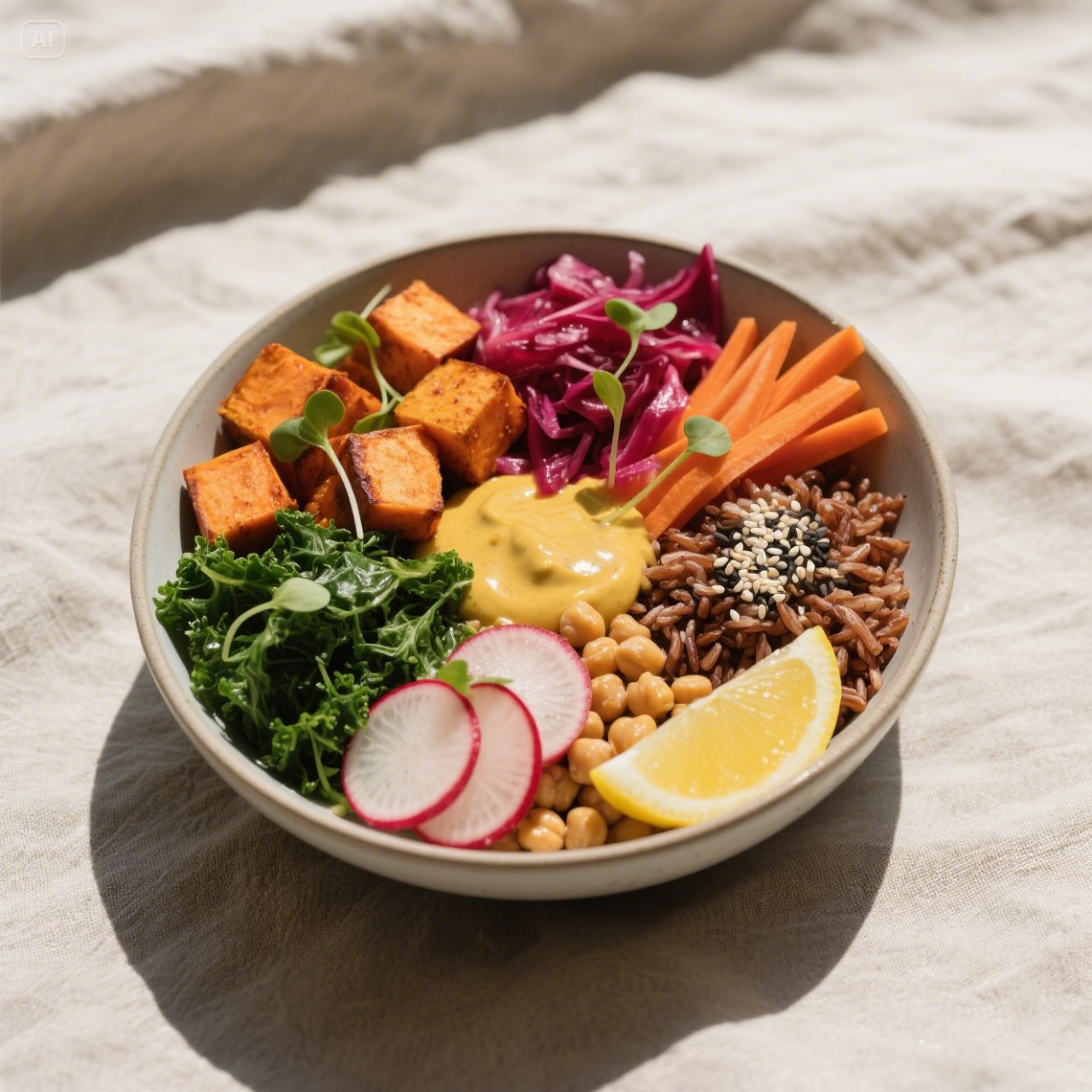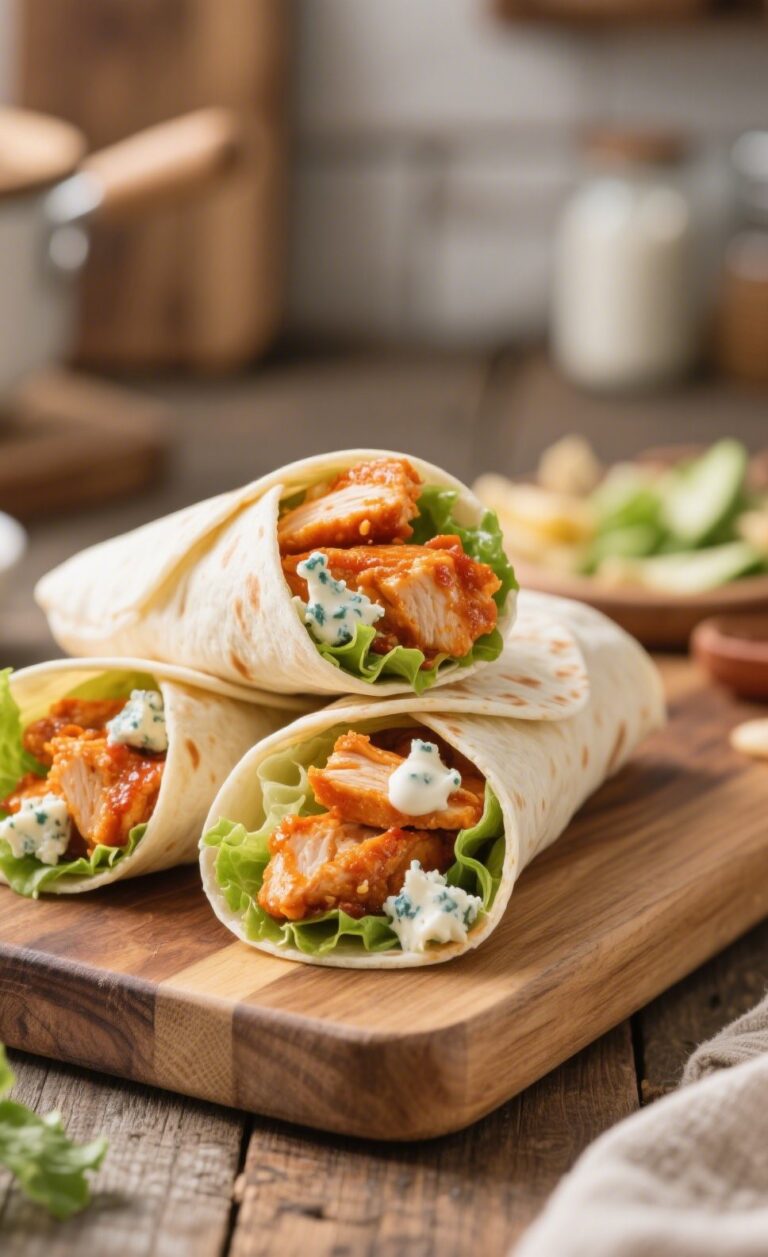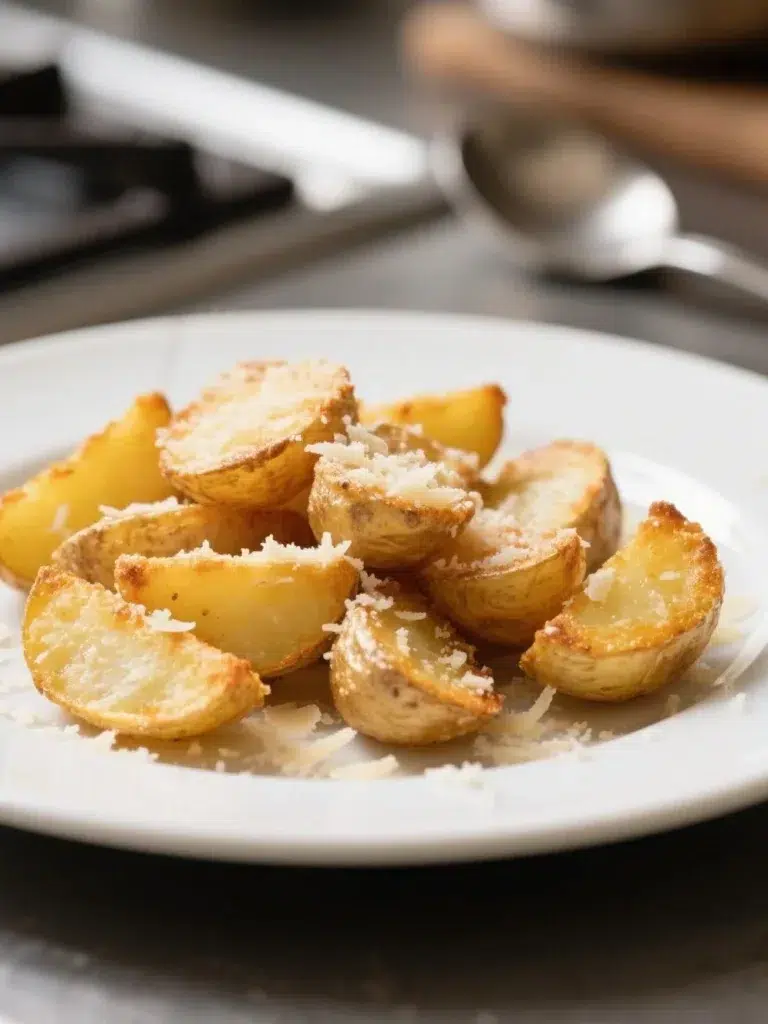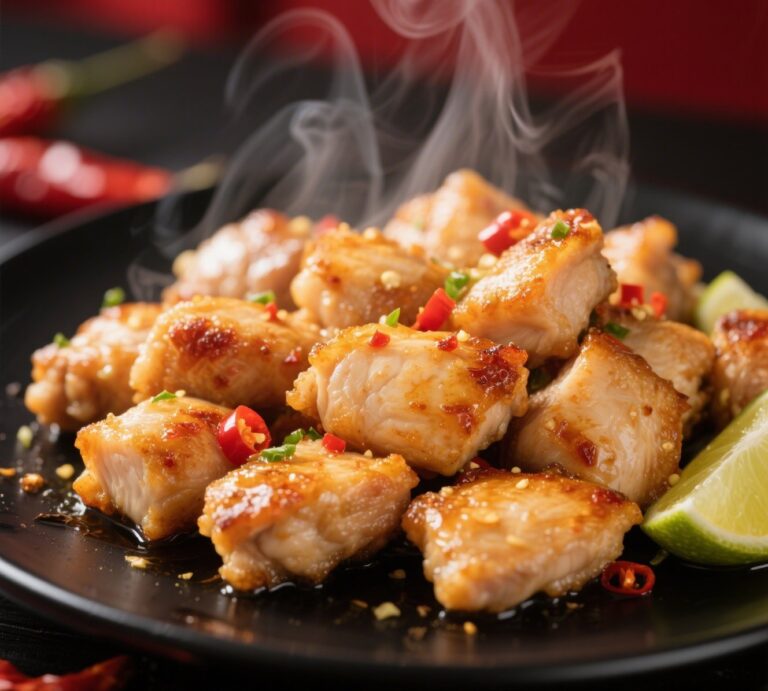Delicious And Nourishing Vegan Buddha Bowl Recipe – 5-Minute Healthy Meal
Eating healthy doesn’t have to be bland or boring—and nothing proves that better than a colorful, flavorful vegan Buddha bowl. This nutrient-packed vegan Buddha bowl brings together vibrant veggies, hearty grains, plant-based proteins, and rich sauces into one nourishing bowl. Whether you’re a seasoned vegan or just trying to add more plants to your diet, the Buddha bowl offers endless possibilities to mix, match, and meal-prep your way to wholesome eating.
In this guide, we’ll explore everything from the origins of Buddha bowls to how to layer them for maximum taste and nutrition. We’ll dive into the best grains, veggies, sauces, and toppings, and wrap it all up with a simple, delicious recipe you can recreate at home. Plus, we’ve included answers to the most common Buddha bowl questions and added expert tips for customization.
Don’t miss our stuffed bell peppers with quinoa and veggies if you’re looking for more plant-packed inspiration.
What Is a Vegan Buddha Bowl?
Origins and Meaning of Buddha Bowl
The term Buddha bowl may sound spiritual, and in a way, it is. While there’s no definitive origin, many believe it refers to the Buddha’s practice of walking around with a bowl to receive small donations of food—resulting in a diverse, nourishing meal. Others link the name to the round, overflowing shape of the bowl itself, resembling a “Buddha belly” after a satisfying meal.
What unites all versions is the concept of balance: each Buddha bowl includes a variety of ingredients that support physical and nutritional well-being.
A vegan Buddha bowl takes this idea further, filling the bowl with only plant-based ingredients. It’s a complete, balanced meal that blends grains, greens, proteins, and healthy fats—all beautifully arranged to look as good as it tastes.
Why It’s Popular Among Plant-Based Eaters
It’s no surprise that Buddha bowls have become a go-to among plant-based eaters. That’s why this vegan Buddha bowl is a favorite among clean eaters and fitness lovers alike:
- Simple yet versatile: You can mix and match ingredients depending on what’s in your fridge.
- Nutrient-dense: Every bowl delivers a wide range of vitamins, minerals, and fiber.
- Perfect for meal prep: Cook once, eat all week.
- Visually appealing: The mix of colors and textures makes it Instagram-worthy and appetite-pleasing.
Looking for inspiration? Try this Mediterranean chickpea salad bowl recipe that shares many ingredients with a classic Buddha bowl.
Whether you’re trying to eat cleaner, add more plants to your plate, or just enjoy a satisfying meal, the vegan Buddha bowl is a delicious place to start.tamins, fiber, antioxidants, and plant protein, making them a top choice for healthy eaters.
Core Components of a Perfect Vegan Buddha Bowl
Creating a vegan Buddha bowl that’s both satisfying and nutritious depends on building it around a few key components. Each plays a vital role in delivering the balance of textures, flavors, and nutrients that make this dish so popular.
The 5 Essential Layers Explained
Use these 5 elements to build a balanced vegan Buddha bowl that tastes amazing and fuels your day:
- Base (Grains or Greens): The foundation of your bowl, usually something like brown rice, quinoa, farro, or leafy greens like kale or spinach.
- Protein (Plant-Based): Ingredients such as chickpeas, tofu, tempeh, lentils, or edamame provide the protein punch needed for energy and satiety.
- Veggies (Roasted & Raw): These add bulk, fiber, color, and nutrients. Use a mix of roasted root veggies like sweet potatoes and raw ones like shredded carrots or cabbage.
- Healthy Fats & Crunch: Think seeds (hemp, sesame), nuts, avocado, or fermented veggies like sauerkraut.
- Sauce or Dressing: A bold, flavorful topping that ties everything together—like a turmeric tahini, peanut, or cashew cream sauce.
This layered approach isn’t just beautiful—it ensures you’re hitting multiple macronutrients and micronutrients in every bite.
Balanced Macros: Grains, Greens, Protein, and More
Here’s a quick table showing how each component contributes to a complete macronutrient profile:
| Layer | Nutrient Focus | Examples |
|---|---|---|
| Base | Complex carbs | Brown rice, quinoa, bulgur, farro |
| Protein | Plant-based protein | Chickpeas, lentils, tofu, tempeh |
| Vegetables | Fiber & vitamins | Kale, radish, carrots, red cabbage |
| Fats | Healthy fats | Sesame seeds, olive oil, avocado, nuts |
| Sauce | Flavor & nutrients | Turmeric tahini, almond dressing, vinaigrettes |
Choosing whole foods in each category helps create a well-rounded meal that satisfies your taste buds and supports sustained energy.
Discover great ideas like this chickpea and spinach curry that makes a perfect protein base for your bowl.
By layering these five elements mindfully, your vegan Buddha bowl becomes more than a meal—it becomes a ritual of self-care.
Building Blocks – The Best Base Options
The foundation of any great vegan Buddha bowl is its base—this is where your nutrients start stacking and your flavors begin to develop. Choosing the right base sets the tone for the rest of your bowl, offering texture, satisfaction, and energy.
Grains and Greens to Start With
There are two main categories of Buddha bowl bases: grains and greens. You can pick one, or better yet, mix both for variety and added nutrition.
Here are some popular and healthy base options:
Grain-Based Foundations
| Grain | Flavor Profile | Benefits |
|---|---|---|
| Brown Rice | Mild, nutty | High in fiber and magnesium |
| Quinoa | Earthy, fluffy | Complete protein, gluten-free |
| Farro | Hearty, chewy | Rich in iron and B vitamins |
| Barley | Slightly sweet, chewy | Great for digestion |
| Couscous (whole wheat) | Light, fluffy | Quick to cook, adds texture |
Leafy Green Foundations
| Green | Taste Profile | Nutrient Highlights |
|---|---|---|
| Kale | Bitter, earthy | High in calcium, iron, and antioxidants |
| Spinach | Mild, soft | Loaded with iron and vitamin A |
| Arugula | Peppery, crisp | Great for digestion and anti-inflammation |
| Mixed Greens | Varied textures | Easy way to add variety |
Tip: For heartier bowls, combine a grain like quinoa with a handful of massaged kale to hit both fiber and phytonutrient targets.
How to Choose Between Quinoa, Rice, or Leafy Kale
When deciding which base to use, consider:
- Satiety: Quinoa and brown rice are better for longer-lasting fullness.
- Lightness: Choose spinach or mixed greens for a lighter, quicker meal.
- Nutritional Profile: Quinoa offers a complete amino acid profile, while kale delivers heavy doses of vitamin K and C.
- Meal Prep Needs: Cooked grains like quinoa and rice store well, while greens like kale should be prepped fresh but can last 2–3 days if massaged with lemon juice.
Looking for inspiration? Try layering your bowl with both brown rice and kale, like in this vibrant vegetarian stir fry noodles recipe that doubles as a delicious grain-veggie base.
Roasted and Raw – The Ideal Veggie Combo
A vegan Buddha bowl is only as good as its vegetables. This is where color, crunch, and comfort all come together. To create a bowl that’s both nutritious and satisfying, it’s important to include a variety of cooked and raw vegetables.
Top Roasted Veggies to Add Flavor
Roasting vegetables brings out their natural sweetness and adds a warm, caramelized flavor that balances the freshness of raw ingredients. Here are some of the best options for Buddha bowls:
| Roasted Veggie | Flavor Notes | Why It Works |
|---|---|---|
| Sweet Potatoes | Sweet, soft, golden | Rich in beta-carotene and satisfying texture |
| Cauliflower | Nutty, slightly crisp | Low-carb and high in fiber |
| Brussels Sprouts | Earthy, roasted bite | Adds umami and crunch |
| Broccoli | Crisp-tender, bold | Antioxidant-rich and hearty |
| Beets | Earthy and sweet | Packed with iron and natural sugars |
In our featured recipe, we roast cubed sweet potatoes with olive oil, salt, and pepper at 400°F for 20 minutes—bringing golden brown perfection and a hint of crisp to your bowl.

Fresh Raw Veggies That Add Crunch and Color
Pairing roasted vegetables with crisp, raw ones creates the ideal texture contrast. Plus, raw veggies provide live enzymes and vitamin C, which can be lost during cooking.
Some colorful raw additions include:
| Raw Veggie | Preparation Method | Benefits |
|---|---|---|
| Carrots | Peeled into ribbons | High in vitamin A, adds crunch |
| Radishes | Thinly sliced (try watermelon radish) | Adds spice and vibrant color |
| Red Cabbage | Shredded or chopped | Anti-inflammatory, rich in antioxidants |
| Cucumber | Thin slices or diced | Hydrating and refreshing |
| Bell Peppers | Julienned | High in vitamin C and fiber |
Tossing these raw veggies in lemon juice, like in our recipe, adds brightness and boosts flavor naturally. You’ll also improve digestion and maximize nutrient absorption.
Looking for more crunchy veggie ideas? Don’t miss our rainbow veggie pasta salad for colorful inspiration that easily doubles as Buddha bowl toppings.
Combining roasted and raw vegetables delivers the best of both worlds—comfort and crunch—all while packing your bowl with fiber, phytonutrients, and flavor.
Plant Proteins That Power Your Bowl
No vegan Buddha bowl is complete without a strong dose of plant-based protein. These protein sources do more than fill you up—they deliver essential amino acids, support muscle health, and bring rich texture to your bowl. And the best part? There are endless ways to keep it both creative and satisfying.
Chickpeas, Tofu, Lentils & More
Let’s break down the most popular protein choices for your Buddha bowl:
| Plant Protein | Flavor & Texture | Why It’s Great in Buddha Bowls |
|---|---|---|
| Chickpeas | Mild, creamy or crispy | High in protein and fiber, easily roasted or spiced |
| Lentils | Earthy, soft | Fast-cooking, high in iron and protein |
| Tofu | Soft or firm, neutral | Absorbs sauces, complete protein |
| Tempeh | Nutty, chewy | Fermented, gut-friendly, high in protein |
| Edamame | Fresh, crunchy | Rich in protein and antioxidants |
| Black Beans | Rich, dense | Bold flavor, great with smoky spices |
In our recipe, we’ve used cooked chickpeas—a pantry staple that’s easy to season, roast, or use plain. Try tossing them with smoked paprika or cumin for an extra kick.
If you’re looking for a protein with a stronger umami taste, sautéed tofu or tempeh slices work beautifully, especially when paired with savory dressings like miso-ginger or sesame-soy.
Combining for Maximum Satiety and Nutrition
Don’t be afraid to mix plant proteins to boost nutritional variety. Here are a few smart combinations:
- Chickpeas + Lentils: Double the fiber and a full amino acid profile.
- Tofu + Edamame: All soy-based but offer varied textures and cooking methods.
- Beans + Seeds: Adding sesame or hemp seeds on top enhances protein without effort.
Each protein brings something different to the bowl—whether it’s the satisfying chew of tempeh, the creaminess of chickpeas, or the crisp bite of pan-fried tofu.
Check out this banana and peanut butter smoothie as a post-meal protein-rich snack that complements your plant-based meal plan.
Sauces & Dressings That Take It to the Next Level
The soul of a vegan Buddha bowl lies in its sauce. This is where flavor meets function. A well-balanced dressing enhances every bite, ties all components together, and often adds healthy fats and anti-inflammatory ingredients. Whether you’re going for zesty, creamy, or spicy—your sauce makes or breaks the bowl.
Turmeric Tahini Sauce & Other Vegan Favorites
Our featured bowl uses a Turmeric Tahini Sauce, which is creamy, earthy, and loaded with anti-inflammatory turmeric. It’s made from:
- Tahini (sesame paste)
- Fresh lemon juice
- Garlic
- Maple syrup or agave (optional)
- Ground turmeric
- Warm water to thin
- Salt and pepper to taste
Blend it all until smooth. This dressing is perfect over roasted sweet potatoes, chickpeas, and kale, adding a warm, nutty balance to bold veggies.
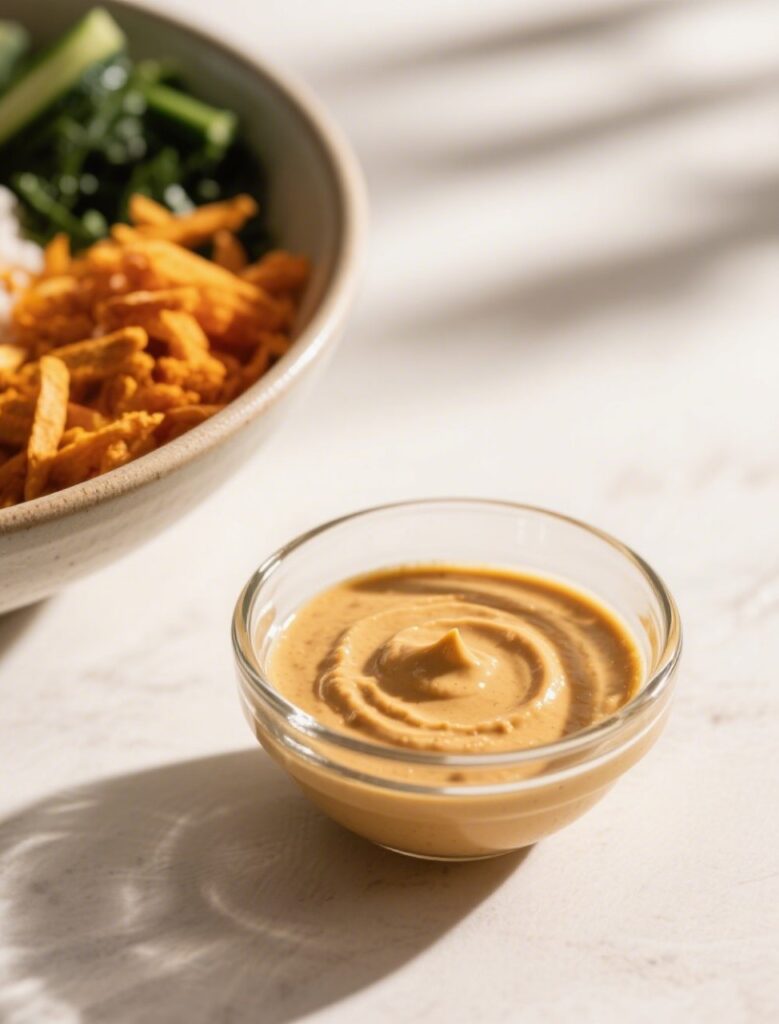
Other standout vegan sauces include:
| Sauce Name | Base Ingredients | Flavor Profile |
|---|---|---|
| Cashew Cream | Soaked cashews, lemon, garlic | Rich, creamy, tangy |
| Miso-Ginger Dressing | White miso, ginger, rice vinegar | Salty, savory, tangy |
| Peanut-Lime Sauce | Peanut butter, soy sauce, lime | Nutty, zesty, slightly sweet |
| Green Goddess Vegan | Avocado, herbs, lemon, olive oil | Fresh, bright, creamy |
Want to switch it up? Use a sauce from our creamy pesto pasta with cherry tomatoes and spinach for a herbaceous twist on your bowl.
How to Mix Flavor Without Overpowering
Here’s how to make sure your sauce elevates without overwhelming:
- Balance the richness: Creamy dressings pair well with spicy or fermented ingredients like sauerkraut.
- Use restraint: Start with 1–2 tablespoons and drizzle more if needed.
- Layer smartly: Drizzle sauces over warm grains or proteins first to help them absorb flavor.
- Play with acidity: A squeeze of lemon or a dash of vinegar can brighten up dense bowls.
Pro Tip: Always keep a batch of your favorite vegan sauce in the fridge. It’s a game changer for fast, healthy meals.
Toppings & Superfood Additions
When it comes to vegan Buddha bowls, the magic is in the details—and toppings are where you can let your creativity shine. They add crunch, contrast, and an extra boost of nutrients that take your bowl from basic to brilliant.
Seeds, Sprouts, and Sauerkraut Benefits
These ingredients might seem small, but they pack a big punch in terms of both flavor and health benefits.
| Topping | Role in the Bowl | Nutritional Highlights |
|---|---|---|
| Sesame Seeds | Adds crunch and nuttiness | Good source of calcium, iron, healthy fats |
| Hemp Seeds | Light texture, nutty flavor | Rich in omega-3s and complete plant protein |
| Sauerkraut | Tangy, fermented vegetable | Supports gut health with probiotics |
| Pickled Veggies | Sharp contrast to creamy sauces | Adds acidity, balances rich flavors |
| Toasted Nuts | Extra crunch and protein | Vitamin E, healthy fats |
In our featured bowl, we use sesame seeds and sauerkraut, which together bring crunch and fermented tang to contrast the creamy turmeric tahini sauce.
Why Fermented Veggies Matter: Fermentation enhances digestion, supports a healthy gut microbiome, and adds a unique depth of flavor that complements roasted and raw vegetables alike.
The Power of Microgreens and Fermented Foods
Want to add a final flourish? Microgreens and fermented foods are small additions that deliver superfood status. Here’s how:
Microgreens
These are young vegetable greens harvested at an early stage and often have higher nutrient levels than their mature counterparts.
- Best Types: Broccoli, arugula, red cabbage, radish microgreens
- Benefits: High in antioxidants, vitamin C, E, and K
- How to Use: Sprinkle a small handful over your bowl just before serving
Fermented Additions
In addition to sauerkraut, consider:
- Kimchi: Spicy fermented cabbage with a probiotic kick
- Pickled onions or beets: Bright, vinegary balance to heavy components
- Tempeh: Fermented soy with a nutty flavor that doubles as a protein
For more topping ideas, don’t miss our stuffed bell peppers recipe which includes topping strategies that can be adapted to Buddha bowls.
Toppings aren’t just about looks—they’re functional ingredients that make your bowl more exciting, digestible, and satisfying.
Step-by-Step Vegan Buddha Bowl Recipe
Now that you know the building blocks of a perfect vegan Buddha bowl, it’s time to put it all together with a step-by-step recipe. This bowl combines warm roasted sweet potatoes, crisp raw veggies, hearty chickpeas, massaged kale, grains, fermented sauerkraut, and a luscious turmeric tahini dressing.
Let’s walk through the process—from prepping ingredients to assembling a bowl that looks as good as it tastes.
Ingredients List (With Quantities)
Here’s everything you’ll need to make 2–3 servings of this satisfying vegan Buddha bowl:
| Ingredient | Amount |
|---|---|
| Sweet potato (cubed) | 1 large |
| Extra-virgin olive oil | For drizzling |
| Radish (watermelon or red) | 1 large or 2 medium |
| Carrots (peeled into ribbons) | 2 medium |
| Red cabbage (shredded) | 1 cup |
| Lemon wedge | For squeezing |
| Kale leaves (chopped) | 8 leaves |
| Cooked brown rice or quinoa | 2 cups |
| Cooked chickpeas or lentils | 1 cup |
| Sauerkraut or fermented veggies | ¾ cup |
| Sesame seeds or hemp seeds | 2 tablespoons |
| Microgreens (optional) | Small handful |
| Sea salt & black pepper | To taste |
| Turmeric Tahini Sauce | To serve |
Simple Instructions for Assembling the Bowl
1. Roast the Sweet Potatoes
Preheat your oven to 400°F and line a baking sheet with parchment paper. Toss the cubed sweet potatoes with olive oil, salt, and pepper. Roast for 20 minutes until golden brown and tender.
2. Prep the Raw Veggies
- Use a mandoline to slice the radish into thin rounds.
- Peel carrots into ribbons with a vegetable peeler.
- Shred the red cabbage finely.
- Toss radish, carrots, and cabbage with a squeeze of lemon for brightness.
3. Massage the Kale
Place chopped kale in a large bowl. Add a few pinches of salt and squeeze of lemon. Use your hands to massage it for 1–2 minutes until it softens and shrinks in volume.
4. Cook Your Base & Protein
Warm the cooked brown rice or quinoa and chickpeas or lentils. You can also spice or pan-fry the chickpeas for extra flavor.
5. Assemble the Bowls
Start with a base of rice/quinoa and kale. Top with roasted sweet potatoes, raw veggie mix, chickpeas, and sauerkraut. Sprinkle with sesame or hemp seeds and microgreens (optional).
6. Add the Sauce
Drizzle generously with Turmeric Tahini Sauce. Finish with freshly ground black pepper.
Quick Recipe Notes:
- Meal Prep Tip: Store each component separately in airtight containers for up to 4 days.
- Serving Tip: Warm components before serving or enjoy the bowl cold—it’s delicious either way.
- Optional Add-ins: Avocado slices, pickled onions, spicy hummus, or crispy tofu cubes.
Looking for a twist on flavor? Try this bowl with a hint of citrus like in our sunrise citrus detox juice.
Storage, Meal Prep, and Variations
One of the biggest advantages of a vegan Buddha bowl is how meal-prep friendly it is. With just a little planning, you can enjoy fresh, balanced meals all week long. Plus, the bowl’s format lends itself beautifully to creative variations so you never get bored.
How to Store for Meal Prep and Freshness
To keep your Buddha bowl components tasting great, store ingredients separately. This helps preserve texture and keeps sauces from making things soggy.
Refrigerator Storage Tips:
| Component | How to Store | Shelf Life (Fridge) |
|---|---|---|
| Cooked grains | In airtight container | Up to 5 days |
| Roasted veggies | Sealed glass container or reusable wrap | 3–4 days |
| Raw veggies | In jars with paper towel for moisture | 2–3 days |
| Chickpeas/lentils | In glass jars or containers | 4–5 days |
| Sauce/dressing | In a sealed mason jar | Up to 1 week |
Pro Tip: Assemble your bowls the night before and add toppings + sauce just before serving.
Buddha Bowl Recipe Variations You’ll Love
There’s no single “right” way to make a vegan Buddha bowl. Here are some creative variations to rotate into your weekly routine:
1. Spicy Asian-Inspired Bowl
- Base: Brown rice or soba noodles
- Protein: Edamame or tofu
- Veggies: Bok choy, carrots, bell peppers
- Sauce: Sesame ginger soy dressing
- Toppings: Toasted sesame seeds, scallions
2. Mediterranean Buddha Bowl
- Base: Quinoa
- Protein: Chickpeas or white beans
- Veggies: Cucumber, cherry tomatoes, olives, spinach
- Sauce: Lemon tahini or vegan tzatziki
- Toppings: Fresh parsley, pine nuts
3. Southwest Power Bowl
- Base: Cilantro-lime brown rice
- Protein: Black beans or grilled tempeh
- Veggies: Corn, avocado, red cabbage, jalapeños
- Sauce: Smoky chipotle cashew cream
- Toppings: Tortilla strips, pumpkin seeds
4. Breakfast Buddha Bowl
- Base: Quinoa or oats
- Protein: Nut butter, hemp seeds
- Veggies/Fruit: Berries, banana slices
- Sauce: Maple almond drizzle
- Toppings: Chia seeds, coconut flakes
Looking for more wholesome combos? Don’t miss our berry apple boost juice to pair with your Buddha bowl breakfast variation.
These variations help keep your meals exciting and ensure you’re getting a wide range of nutrients from week to week.
Frequently Asked Questions (FAQs) About Vegan Buddha Bowls:
What is in a vegan Buddha bowl?
A vegan Buddha bowl typically includes a combination of cooked grains (like brown rice or quinoa), leafy greens, a variety of roasted and raw vegetables, a plant-based protein (such as chickpeas, lentils, or tofu), and a flavorful sauce like tahini or miso dressing. Toppings such as seeds, fermented vegetables, and microgreens are often added for extra texture and nutrition.
What are the 5 components of a Buddha bowl?
The five key components are:
Base – Whole grains or greens
Protein – Plant-based, like beans, lentils, tofu
Veggies – Roasted and raw for flavor and crunch
Sauce – Creamy or zesty to tie flavors together
Toppings – Seeds, fermented foods, or herbs for added nutrients
These layers make the Buddha bowl balanced, beautiful, and packed with nutrients.
Are Vegan Buddha bowls healthy?
Yes, Buddha bowls are incredibly healthy. They offer a well-rounded balance of complex carbs, protein, fiber, healthy fats, and vitamins. Because they emphasize whole, unprocessed plant foods, they support digestive health, heart health, and sustained energy.
How to make a poke bowl vegan?
To make a poke bowl vegan, swap out raw fish for marinated plant-based alternatives like:
Cubed tofu (marinated in tamari, sesame oil, and rice vinegar)
Watermelon tuna (seasoned and chilled watermelon)
Chickpeas or tempeh
Pair them with sushi rice, cucumber, edamame, avocado, and seaweed salad. Top with vegan-friendly spicy mayo or sesame soy dressing.
Why is it called a Vegan Buddha bowl?
The term “Buddha bowl” is believed to reference either the rounded, overfilled bowl shape (symbolic of a “Buddha belly”) or the concept of balance and nourishment found in Buddhist traditions. Some say it’s inspired by monks who collected food in a bowl from donations, resulting in a naturally varied and wholesome mix.
What is the base of a Vegan Buddha bowl?
The base is typically a whole grain (like quinoa, rice, or farro) or a leafy green (like kale or spinach). Many bowls use both, starting with greens and layering cooked grains on top for texture and nutrition.
Elevate Your Plant-Based Lifestyle with the Ultimate Vegan Buddha Bowl
Whether you’re vegan, vegetarian, or just looking to eat more whole, nutritious foods, the vegan Buddha bowl is a vibrant and satisfying solution. With its endless combinations of grains, greens, proteins, and veggies—plus flavorful sauces and nourishing toppings—it delivers everything your body craves in one beautiful bowl.
The Buddha bowl is more than a trend—it’s a lifestyle choice that celebrates balance, simplicity, and flavor. Perfect for meal prep or spontaneous weeknight dinners, it adapts easily to seasonal produce and personal tastes.
Looking for more plant-powered dishes?
Discover great ideas like vegetarian stir fry noodles
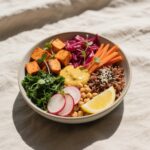
Vegan Buddha Bowl with Turmeric Tahini Sauce
- Total Time: 40 minutes
- Yield: 2–3 bowls 1x
- Diet: Vegan
Description
A vibrant, nutrient-packed vegan Buddha bowl featuring roasted sweet potatoes, massaged kale, crisp raw veggies, chickpeas, and a creamy turmeric tahini sauce. Perfect for meal prep, gluten-free, and endlessly customizable.
Ingredients
1 large sweet potato, cubed
Extra-virgin olive oil, for drizzling
1 watermelon radish or 2 red radishes, thinly sliced
2 medium carrots, peeled into ribbons
1 cup shredded red cabbage
1 lemon wedge, for squeezing
8 kale leaves, chopped
2 cups cooked brown rice or quinoa
1 cup cooked chickpeas or cooked lentils
¾ cup sauerkraut or other fermented veggies
2 tablespoons sesame seeds or hemp seeds
Microgreens, optional
Sea salt and freshly ground black pepper, to taste
Turmeric Tahini Sauce, for serving
Instructions
-
Preheat oven to 400°F (200°C). Line a large baking sheet with parchment paper.
-
Toss the cubed sweet potatoes with olive oil, salt, and pepper. Spread onto the baking sheet and roast for 20 minutes, or until golden brown and tender.
-
While potatoes roast, prep the raw veggies: thinly slice radish, peel carrots into ribbons, and shred cabbage. Toss them with a squeeze of lemon and set aside.
-
Place chopped kale into a bowl, add a squeeze of lemon and a pinch of salt. Massage with your hands until wilted and tender.
-
Warm the cooked brown rice or quinoa and the chickpeas or lentils if serving warm.
-
Assemble bowls: Add grains, kale, roasted sweet potatoes, raw veggie mix, chickpeas, and sauerkraut to each bowl.
-
Top with sesame seeds or hemp seeds, microgreens if using, and drizzle generously with turmeric tahini sauce. Season with salt and pepper to taste.
Notes
You can swap chickpeas for lentils, tofu, or tempeh.
Use red cabbage for vibrant color and crunch, or green cabbage as an alternative.
Store all components separately in airtight containers for up to 4 days for meal prep.The turmeric
tahini sauce can be made up to a week in advance and kept refrigerated.
- Prep Time: 20 minutes
- Cook Time: 20 minutes
- Category: Trending recipe
- Method: Roasting
- Cuisine: Plant-Based
Nutrition
- Serving Size: 1
- Calories: 500
- Sugar: 6
- Sodium: 420
- Fat: 15
- Carbohydrates: 65
- Fiber: 12
- Protein: 18

